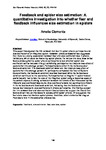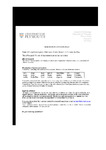Feedback and spider size estimation: A quantitative investigation into whether fear and feedback influences size estimation in spiders
| dc.contributor.author | Clements, A. | |
| dc.date.accessioned | 2022-07-28T16:53:10Z | |
| dc.date.available | 2022-07-28T16:53:10Z | |
| dc.date.issued | 2022 | |
| dc.identifier.citation |
Clements, A. (2022) 'Feedback and spider size estimation: A quantitative investigation into whether fear and feedback influences size estimation in spiders', The Plymouth Student Scientist, 15(1), pp. 146-159. | en_US |
| dc.identifier.uri | http://hdl.handle.net/10026.1/19455 | |
| dc.description.abstract |
This paper investigated the link between trait fear in spider phobic participants and size estimation of an imagined spider. However, previous research has suggested that there is a strong association between fear and size estimation bias in phobic individuals, which could be mediating spider phobia. To reduce this bias, false verbal feedback was given to spider phobic participants to test whether spider size estimation can be reduced through convincing participants that they are less afraid of spiders than the average person. Participants were either in the no feedback or feedback condition. The feedback condition were told that they are less afraid of spiders than the average person. All participants completed the Fear of Spiders Questionnaire, the feedback condition received feedback while the no feedback condition continued to the scenarios. Participants had to imagine 11 spider related scenarios and had to rate the size of the imagined spider using a response scale of household objects. A strong correlation between trait levels of fear measured by the FSQ and size estimation was found. Size estimations were not significantly different in the no feedback and feedback condition, indicating that the feedback did not reduce fear levels and size estimations in phobic participants. The findings support the link between fear and size estimation bias but does not support the theory that feedback can reduce this bias and subsequently spider phobia. This suggests that fear alone does not mediate spider phobia, therefore, other elements like disgust may play a role in the avoidance process too. | en_US |
| dc.language.iso | en | en_US |
| dc.publisher | University of Plymouth | en_US |
| dc.rights | Attribution 3.0 United States | * |
| dc.rights.uri | http://creativecommons.org/licenses/by/3.0/us/ | * |
| dc.subject | Feedback | en_US |
| dc.subject | size estimation | en_US |
| dc.subject | fear | en_US |
| dc.subject | size bias | en_US |
| dc.subject | spider | en_US |
| dc.title | Feedback and spider size estimation: A quantitative investigation into whether fear and feedback influences size estimation in spiders | en_US |
| dc.type | Article | en_US |
| plymouth.issue | 1 | |
| plymouth.volume | 15 | |
| plymouth.journal | The Plymouth Student Scientist |




